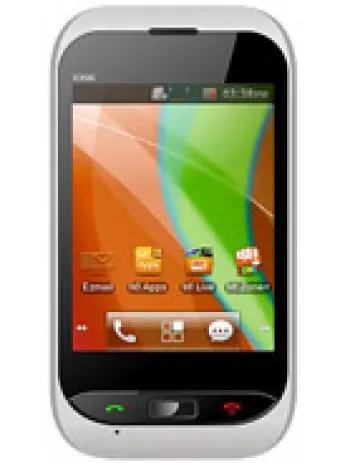
Introduction to Micromax GC275
In the world of feature phones, the Micromax GC275 stood out as a handy device for those looking for basic communication needs at a competitive price point. Released in 2010, the device came in a compact form and offered dual SIM capabilities. Let's dive into the detailed specifications and features of this device to fully appreciate what it brought to the marketplace during its active years.
Network and Connectivity
The Micromax GC275 was designed to support GSM/CDMA technology which was a significant advantage as it catered to a broader range of users who may have different network requirements. The phone supported 2G bands of GSM 900 and 1800, which were widely used in different regions. GPRS Class 10 was available, enabling basic data services, although EDGE was not supported. The connectivity options were fairly limited, but standard for feature phones of that period.
Launch Details and Availability
Announced and released in 2010, the Micromax GC275 quickly found its place in the feature phone segment. It was eventually discontinued, but during its time, it served as a practical device for several users who needed basic connectivity without the complexities of a smartphone.
Design and Build
Weighing about 100 grams and with dimensions of 107.7 x 44.4 x 14.5 mm, the Micromax GC275 was quite compact and portable. It featured a classic candy bar design with a Mini-SIM slot, catering to the prevalent SIM card format of the time. The design was tailored for durability and ease of use, making it comfortable to carry and operate with one hand.
Display Features
The phone boasted a TFT display with support for 65K colors, suitable for basic visual needs. While the size and resolution details of the screen are unspecified, feature phones of this era typically had small screens suitable primarily for tasks like texting and calling.
Memory and Storage
For memory options, the Micromax GC275 had a dedicated slot for microSD cards, allowing users to expand storage and store more contacts, messages, and media files. The phone supported a phonebook and call record features, which were essential for managing contacts and call history.
Camera Capabilities
This device came with a basic 0.3MP camera. While not designed for high-quality photography, the inclusion of a camera allowed users to capture simple snapshots and videos, enhancing its usability over phones without any camera capabilities.
Audio and Sound Features
The Micromax GC275 featured a loudspeaker for audio output but lacked a 3.5mm jack, which was a minor limitation for those preferring traditional wired headphones. However, the phone did support Bluetooth connectivity with A2DP for wireless audio streaming, compensating somewhat for the lack of a headphone jack.
Communications and Messaging
With no support for WLAN, the Micromax GC275 is primarily designed for communication via SMS and MMS. The phone offered WAP 2.0/xHTML browsing capabilities, which allowed for basic mobile internet browsing. Additionally, it supported Java MIDP 2.0, enabling the download of simple Java-based applications and games.
Radio and Additional Features
A stereo FM radio feature was included, making it possible for users to listen to radio broadcasts on the go. This feature added value to the device, especially in regions where radio is a primary source of news and entertainment. The phone also supported proprietary USB connections for charging and data transfer.
Battery Life and Performance
Equipped with a removable Li-Ion 800 mAh battery, the Micromax GC275 promised up to 240 hours of standby time and approximately 6 hours and 40 minutes of talk time. These battery statistics made it a reliable choice for users who needed a phone that could last through the day on a single charge.
Price and Market Position
Priced at about 40 EUR upon its release, the Micromax GC275 was positioned as an affordable option for budget-conscious consumers. Its pricing strategy made it accessible to a wide audience seeking basic phone functionalities without the advanced features of more expensive smartphones.
Conclusion
Overall, the Micromax GC275 served its purpose well as a feature phone in 2010. Its simple design, essential features, and affordability made it a practical choice for users who prioritized communication and basic multimedia capabilities. Although it has been discontinued, its impact in the budget phone segment remains noteworthy as it demonstrated the balance between cost and functionality in mobile technology.
Key Features of Micromax GC275
- Supports Dual Network Technology: GSM and CDMA
- Compact and Lightweight Body: 107.7 x 44.4 x 14.5 mm, 100 g
- Expandable Memory: Dedicated microSD card slot
- TFT Display with 65K colors
- Basic Camera with Video Recording
- Bluetooth Support with A2DP
- Stereo FM Radio
- Support for SMS and MMS Messaging
- Includes Java MIDP 2.0 for Additional Apps
- Removable Li-Ion 800 mAh Battery with Up to 240 hours Stand-by Time
Micromax GC275 Key Disadvantages
- Lacks 3G/4G network support, limited to GSM/CDMA 2G bands.
- No EDGE support for higher data speeds.
- Display size and resolution are unspecified, which could indicate a lack of quality.
- No front (selfie) camera available.
- No 3.5mm headphone jack for standard headphones use.
- Lacks Wi-Fi connectivity options.
- No GPS positioning technology for navigation services.
- USB connection requires a proprietary cable rather than a standard connector.
- Only provides basic browser support (WAP 2.0/xHTML).
- Battery capacity is relatively low (800 mAh), which may lead to frequent charging.
- Device is discontinued and no longer supported by manufacturer updates or services.
- Available in only one color (Black), limiting personalization options.
View Also
More Phones
All Rights Reserved +14266 Phones © Mobilawy 2025

























